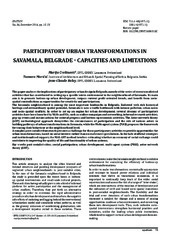Participatory urban transformations in Savamala, Belgrade - capacities and limitations
Апстракт
This paper analyses the implications of participatory urban design in Belgrade, namely of the series of recent unsolicited activities that has contributed to setting up a specific micro environment in the neighbourhood of Savamala. Its main aim is to promote bottom-up urban development, surpass current profit-oriented trends, and benefit from socio-spatial contradictions as opportunities for creativity and participation. The Savamala neighbourhood is among the most important landmarks in Belgrade. Endowed with rich historical heritage and extraordinary spatial potential, Savamala is now a traffic bottleneck with intense pollution, urban noise and socio-spatial conflicts. In order to set up an engine for urban development, several streams of participatory activities have been launched by NGOs and IOs, such as: online campaigns and networking, informal research activities, pop-up events and instant actions for societal progress and bottom-up economic activities. The Actor-network theory ...(ANT) methodological approach demystifies the circumstances of participation and the role of various actors in building pathways of urban transformations in Savamala, while the Multi-agent system (MAS) proposes the framework for tracing their behaviour at the neighbourhood level. A complex post-socialist framework presents a challenge for these participatory activities to provide opportunities for urban transformations, based on social interest rather than on real estate speculations. In the lack of official strategies and institutionalised support, the MAS-ANT method involves estimating whether an economy of social exchange could contribute to improving the quality of life and functionality of urban systems.
Кључне речи:
Actor-network theory (ANT) / Multi-agent system (MAS) / Post-socialist cities / Social participation / Urban developmentИзвор:
Spatium, 2016, 1, 36, 15-23Издавач:
- Institute of Architecture, Urban & Spatial Planning of Serbia
Финансирање / пројекти:
- Boundary Layer structure and exchange processes in an Alpine valley (SNSF/Project funding)
- Support to Process of Urban Development in Serbia (SPUDS) (SCOPES programme, no. 160503)
Група
RAUmPlanTY - JOUR AU - Cvetinović, Marija AU - Maričić, Tamara AU - Bolay, J.-C. PY - 2016 UR - https://raumplan.iaus.ac.rs/handle/123456789/264 AB - This paper analyses the implications of participatory urban design in Belgrade, namely of the series of recent unsolicited activities that has contributed to setting up a specific micro environment in the neighbourhood of Savamala. Its main aim is to promote bottom-up urban development, surpass current profit-oriented trends, and benefit from socio-spatial contradictions as opportunities for creativity and participation. The Savamala neighbourhood is among the most important landmarks in Belgrade. Endowed with rich historical heritage and extraordinary spatial potential, Savamala is now a traffic bottleneck with intense pollution, urban noise and socio-spatial conflicts. In order to set up an engine for urban development, several streams of participatory activities have been launched by NGOs and IOs, such as: online campaigns and networking, informal research activities, pop-up events and instant actions for societal progress and bottom-up economic activities. The Actor-network theory (ANT) methodological approach demystifies the circumstances of participation and the role of various actors in building pathways of urban transformations in Savamala, while the Multi-agent system (MAS) proposes the framework for tracing their behaviour at the neighbourhood level. A complex post-socialist framework presents a challenge for these participatory activities to provide opportunities for urban transformations, based on social interest rather than on real estate speculations. In the lack of official strategies and institutionalised support, the MAS-ANT method involves estimating whether an economy of social exchange could contribute to improving the quality of life and functionality of urban systems. PB - Institute of Architecture, Urban & Spatial Planning of Serbia T2 - Spatium T1 - Participatory urban transformations in Savamala, Belgrade - capacities and limitations VL - 1 IS - 36 SP - 15 EP - 23 DO - 10.2298/SPAT1636015C ER -
@article{
author = "Cvetinović, Marija and Maričić, Tamara and Bolay, J.-C.",
year = "2016",
abstract = "This paper analyses the implications of participatory urban design in Belgrade, namely of the series of recent unsolicited activities that has contributed to setting up a specific micro environment in the neighbourhood of Savamala. Its main aim is to promote bottom-up urban development, surpass current profit-oriented trends, and benefit from socio-spatial contradictions as opportunities for creativity and participation. The Savamala neighbourhood is among the most important landmarks in Belgrade. Endowed with rich historical heritage and extraordinary spatial potential, Savamala is now a traffic bottleneck with intense pollution, urban noise and socio-spatial conflicts. In order to set up an engine for urban development, several streams of participatory activities have been launched by NGOs and IOs, such as: online campaigns and networking, informal research activities, pop-up events and instant actions for societal progress and bottom-up economic activities. The Actor-network theory (ANT) methodological approach demystifies the circumstances of participation and the role of various actors in building pathways of urban transformations in Savamala, while the Multi-agent system (MAS) proposes the framework for tracing their behaviour at the neighbourhood level. A complex post-socialist framework presents a challenge for these participatory activities to provide opportunities for urban transformations, based on social interest rather than on real estate speculations. In the lack of official strategies and institutionalised support, the MAS-ANT method involves estimating whether an economy of social exchange could contribute to improving the quality of life and functionality of urban systems.",
publisher = "Institute of Architecture, Urban & Spatial Planning of Serbia",
journal = "Spatium",
title = "Participatory urban transformations in Savamala, Belgrade - capacities and limitations",
volume = "1",
number = "36",
pages = "15-23",
doi = "10.2298/SPAT1636015C"
}
Cvetinović, M., Maričić, T.,& Bolay, J.-C.. (2016). Participatory urban transformations in Savamala, Belgrade - capacities and limitations. in Spatium Institute of Architecture, Urban & Spatial Planning of Serbia., 1(36), 15-23. https://doi.org/10.2298/SPAT1636015C
Cvetinović M, Maričić T, Bolay J. Participatory urban transformations in Savamala, Belgrade - capacities and limitations. in Spatium. 2016;1(36):15-23. doi:10.2298/SPAT1636015C .
Cvetinović, Marija, Maričić, Tamara, Bolay, J.-C., "Participatory urban transformations in Savamala, Belgrade - capacities and limitations" in Spatium, 1, no. 36 (2016):15-23, https://doi.org/10.2298/SPAT1636015C . .



